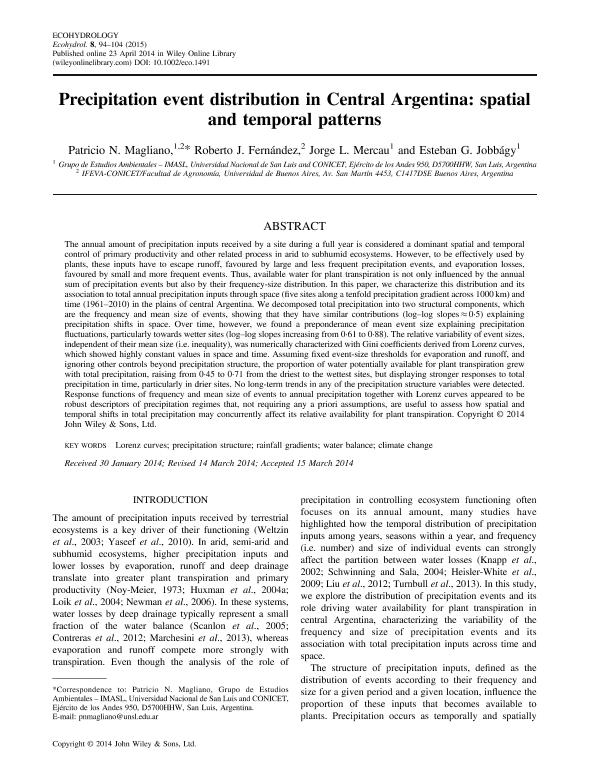Artículo
Precipitation event distribution in central argentina: Spatial and temporal patterns
Magliano, Patricio Nicolás ; Fernandez, Roberto Julio; Mercau, Jorge Luis; Jobbagy Gampel, Esteban Gabriel
; Fernandez, Roberto Julio; Mercau, Jorge Luis; Jobbagy Gampel, Esteban Gabriel
 ; Fernandez, Roberto Julio; Mercau, Jorge Luis; Jobbagy Gampel, Esteban Gabriel
; Fernandez, Roberto Julio; Mercau, Jorge Luis; Jobbagy Gampel, Esteban Gabriel
Fecha de publicación:
01/2015
Editorial:
John Wiley & Sons Inc
Revista:
Ecohydrology
ISSN:
1936-0584
Idioma:
Inglés
Tipo de recurso:
Artículo publicado
Clasificación temática:
Resumen
The annual amount of precipitation inputs received by a site during a full year is considered a dominant spatial and temporal control of primary productivity and other related process in arid to subhumid ecosystems. However, to be effectively used by plants, these inputs have to escape runoff, favoured by large and less frequent precipitation events, and evaporation losses, favoured by small and more frequent events. Thus, available water for plant transpiration is not only influenced by the annual sum of precipitation events but also by their frequency-size distribution. In this paper, we characterize this distribution and its association to total annual precipitation inputs through space (five sites along a tenfold precipitation gradient across 1000km) and time (1961-2010) in the plains of central Argentina. We decomposed total precipitation into two structural components, which are the frequency and mean size of events, showing that they have similar contributions (log-log slopes≈0·5) explaining precipitation shifts in space. Over time, however, we found a preponderance of mean event size explaining precipitation fluctuations, particularly towards wetter sites (log-log slopes increasing from 0·61 to 0·88). The relative variability of event sizes, independent of their mean size (i.e. inequality), was numerically characterized with Gini coefficients derived from Lorenz curves, which showed highly constant values in space and time. Assuming fixed event-size thresholds for evaporation and runoff, and ignoring other controls beyond precipitation structure, the proportion of water potentially available for plant transpiration grew with total precipitation, raising from 0·45 to 0·71 from the driest to the wettest sites, but displaying stronger responses to total precipitation in time, particularly in drier sites. No long-term trends in any of the precipitation structure variables were detected. Response functions of frequency and mean size of events to annual precipitation together with Lorenz curves appeared to be robust descriptors of precipitation regimes that, not requiring any a priori assumptions, are useful to assess how spatial and temporal shifts in total precipitation may concurrently affect its relative availability for plant transpiration.
Archivos asociados
Licencia
Identificadores
Colecciones
Articulos(IFEVA)
Articulos de INST.D/INV.FISIOLOGICAS Y ECO.VINCULADAS A L/AGRIC
Articulos de INST.D/INV.FISIOLOGICAS Y ECO.VINCULADAS A L/AGRIC
Articulos(IMASL)
Articulos de INST. DE MATEMATICA APLICADA DE SAN LUIS
Articulos de INST. DE MATEMATICA APLICADA DE SAN LUIS
Citación
Magliano, Patricio Nicolás; Fernandez, Roberto Julio; Mercau, Jorge Luis; Jobbagy Gampel, Esteban Gabriel; Precipitation event distribution in central argentina: Spatial and temporal patterns; John Wiley & Sons Inc; Ecohydrology; 8; 1; 1-2015; 94-104
Compartir
Altmétricas



